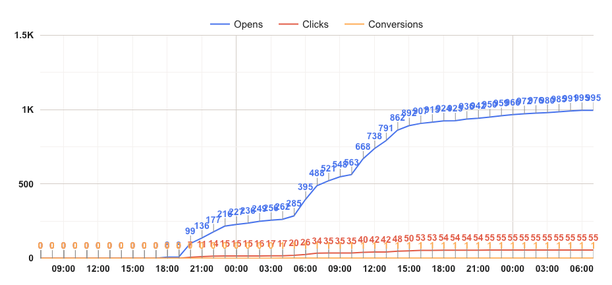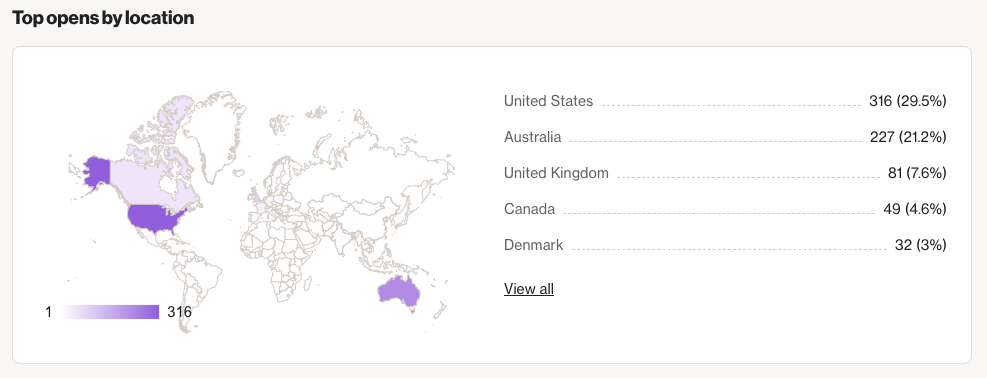Understanding email campaign reports
Overview
Email campaign reports in Ortto provide an overview of users email performance, with the option to download the report as a PDF. This guide covers key metrics, conversions, top-performing links and more.
Accessing email reports
Navigate to Marketing > Campaigns > Select your Campaign > Select Report.
Report metrics
Learn more about how campaign statistics are calculated.
IMPORTANT:
- Currently, by default, our reports include non-human interactions, such as those caused by Apple’s Mail Privacy Protection (MPP) service. Since we can’t differentiate these from real opens without also missing genuine recipient interactions, we have chosen not to remove these from reports by default.
- However, we do have a way for customers to easily identify and ignore these themselves in their automations and reports via the “Possible machine open” field logged for open activities related to this service. Our team can assist with help on setting up such filters if needed.
Performance
The performance section of the report gives you an overview of key metrics, including:
- Open rate % > Percentage of recipients who opened the email (Opened ÷ Delivered).
- Click rate % > Percentage of recipients who clicked a link in the email (Clicked ÷ Delivered).
- Conversions > Number of actions completed by contacts, such as purchases or sign-ups, after clicking on the email.
- MRR (Monthly recurring revenue) > The amount of revenue generated monthly from the email campaign's conversions (e.g., subscription sign-ups).
- Sent > Number of emails sent.
- Delivered > Number of emails successfully delivered to inboxes.
- Opened > Number of unique opens.
- Last opened > The most recent time the email was opened.
- Click-to-open rate > Compares the number of unique clicks to unique opens.
- Viewed online > Number of times the email was viewed in a web browser.
- Unsubscribed > Number of contacts who unsubscribed from your email list.
- Invalid > Number of emails marked as invalid.
- Bounced > Number of emails that couldn’t be delivered (hard or soft bounce).
- Clicked > Number of unique clicks on links within the email.
- Last clicked > The most recent time a contact clicked a link in the email.
- Forwarded > Number of times the email was forwarded to others.
- Sentiment > Overall feedback on the email (positive, neutral, or negative).
- Spam complaints > Number of contacts who marked the email as spam.
Data aggregation and archived contacts
Report data is updated once a day to capture the activities and engagement of all active contacts at that time.
If you archive a contact before the daily update, their activities will not be included in the report. However, once the data is updated, the recorded activity totals will remain, even if the contact is archived afterward.
TIP: To ensure accurate campaign reporting, wait at least two days after sending a campaign before archiving contacts.
Open-click graph
An Open-click graph visualizes the relationship between email opens and link clicks within a campaign, based on the time of day. It shows when recipients are opening your email and clicking on links, helping you understand engagement patterns and optimize your send times.

Top links
Top Links show the most clicked links within your email campaign, helping you identify which content or call-to-action drove the most engagement.
- Base URL: The base URL with all query string data removed. This option consolidates clicks for similar links, especially useful when variations of a link share a common base URL.
- Raw URL: The original link configured by your team, including merge tags and dynamic content but before the variable personalization is processed for each recipient.
- Final URL: The actual destination link that the recipient clicked on in the campaign. This provides precise information about where the clicks led.
Top opens by location
The Top opens by location report shows where your email recipients are located based on their geographic data. It helps you understand which regions or countries are engaging most with your campaign, allowing you to tailor your strategy accordingly.

Attributed conversions and MRR
These metrics help you track revenue and conversions tied to your campaign, allowing you to measure the financial impact of your efforts.
- Revenue / MRR / ARR: The total sum of revenue attributed to this campaign or message based on your attribution settings.
- Conversions / orders: The sum of activities attributed to the campaign where the attribution activity has a conversion value.
- Conversion rate: The percentage of conversions attributed to the campaign or message. Formula: (Conversions / Emails Delivered) * 100

Example of conversion and revenue metrics.
How are conversions tracked for a campaign
A conversion for a campaign is tracked when a contact completes the specified activity within the attribution window set in the settings.
EX: Let’s say you select the Placed order activity as the attribution activity for a certain email, and the attribution window is set to 10 days.
If a contact places an order (thus triggering the Placed order activity) within 10 days of receiving the email, that order will be attributed to the email.
You can set the attribution to trigger when someone receives an email, opens an email, or clicks a link. Learn more about touch triggers.
How is the revenue calculated for a campaign
The revenue for a campaign is calculated based on a specific attribute within the attribution activity. This attribute varies by activity, and some activities don’t have a revenue attribute (e.g., the Submitted widget form activity doesn't have a revenue attribute).
EX: Let’s say you select the Placed order activity as the attribution activity. By default, we use the Total attribute to calculate the revenue.
If a contact who engaged with the email via the specified touch trigger places an order (thus triggering the Placed order activity) within the attribution window, the revenue (the value of the Total attribute) will be automatically attributed to the campaign.
NOTE:
- If the activity doesn’t have a revenue attribute, the conversion itself will still count, but the revenue won’t change.
- If you're using a custom activity, you can specify a conversion value to be used as the attribute for calculating the revenue in Ortto.
TIP: If the conversion or revenue numbers don’t match your Google Analytics, this may be due to several different factors.
Learn more about data discrepancy between Ortto and Google Analytics.
Reactions
In the past, email metrics only showed opens and clicks, but those don’t always reflect how recipients feel about your content. Reactions give you a new metric—sentiment—which tells you whether subscribers are Positive, Neutral, or Negative about your campaign.
The benefits of sentiment include:
- Getting ongoing feedback beyond opens and clicks.
- Reducing unsubscribe rates, as subscribers may react negatively instead of unsubscribing, giving you a chance to improve.
- Staying motivated with positive feedback on your content.
Learn more about email campaign reactions.
